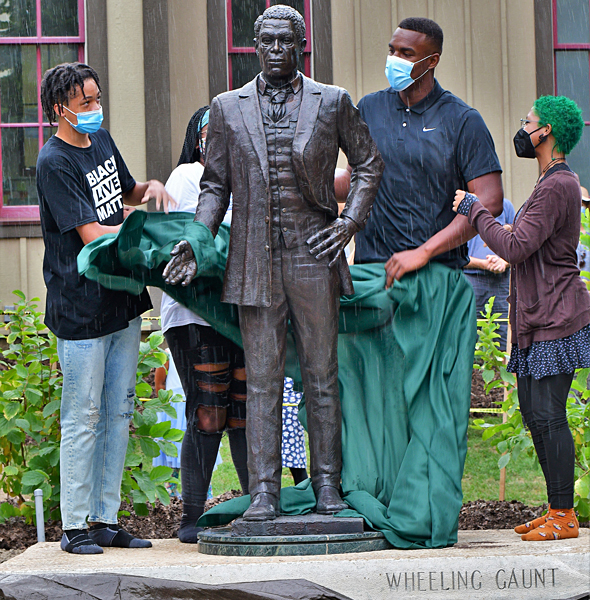
After four years of planning, the Wheeling Gaunt sculpture was unveiled on Saturday, Oct. 2. The statue of the 19th-century village resident and formerly enslaved man stands at Hilda M. Rahn Park. Pictured here uncovering the statue are, from left, YSHS students Malcolm Blunt, Gini Meekin (obscured), Aamil Wagner and Malaya Booth. (Photo by Kathleen Galarza)
Wheeling Gaunt sculpture unveiled in downtown Yellow Springs
- Published: October 12, 2021
Standing over six-feet tall and glinting with a deep bronze exterior, a lifesize statue of 19th-century Yellow Springs resident, philanthropist and formerly enslaved man Wheeling Gaunt, was unveiled on Saturday, Oct. 2, to joyous celebration and fanfare.
Set at Hilda M. Rahn Park, located at the corner of Dayton Street and Xenia Avenue in downtown Yellow Springs, the Wheeling Gaunt statue symbolically faces north.
Adorned with a stately coat and tie, he stands atop a pedestal inscribed with his name and a quote widely attributed to him: “Not what we have, but what we share.”
Gaunt’s right hand is extended, as if cordially inviting passersby into the village.
The statue is sited at the rear of an oval-shaped pad of pavers, still under construction. Upon the site’s completion, the hardscaped platform will feature geometric patterns that evoke an Underground Railroad-era Freedom Quilt motif.
Benches, native trees and other landscaping will soon be added to the park. Taken together, the statue and the surrounding features amount to what has been dubbed “Gaunt Plaza” by project organizers.
Whereas the Wheeling Gaunt statue was completed by sculptor Anthony Maughan, the son of the late artist and longtime village resident Brian Maughan, the orchestration and organization of the project was under the purview of the Yellow Springs Arts Council and was a community wide effort, led by several project committees, said Project Manager Cheryl Durgans — who is also the editor of the YS News.
Jerome Borchers, president of the Arts Council, told the News in an interview after the ceremony that the project — from its inception — has taken nearly four years. But as he indicated, there’s still much to be done.
“The unveiling of the statue was just the beginning,” Borchers said.
The unveiling ceremony
Scores of villagers and visitors alike turned out for the unveiling last Saturday afternoon. Before the statue was revealed, project leaders, Village officials and local historians took the stage and spoke on the significance of the occasion.
The event kicked off with an energetic opening ceremony, featuring drumming and a call to ancestors.
“This is about acknowledging lineage, history and community,” Durgans said at the outset of the program. “[The call to ancestors] is one of the most important parts of the ceremony because it shows us how we’re going to move forward with intention as a community.”
Durgans called out to the crowd, and asked for a local elder to grant permission to begin the program. Resident Paul Graham, 92, stood up and issued his blessings.
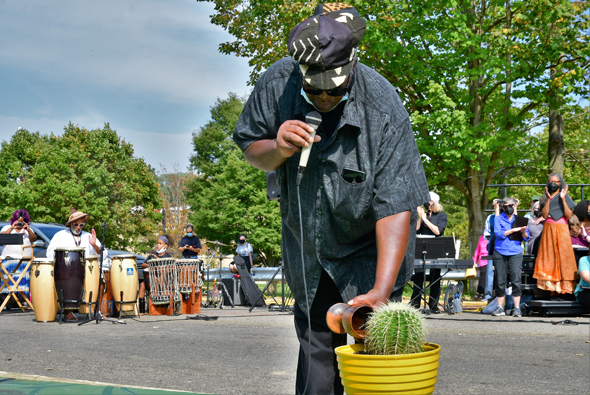
Bomani Moyenda conducts an homage to ancestors. (Photo by Kathleen Galarza)
Villager and longtime local activist Bomani Moyenda then took the stage and asked for the audience to call out the names of deceased Yellow Springs residents who’ve “paved the way to the village we know now, so we may welcome their spirits as they join us today.” And with each of the names spoken, Moyenda watered a small cactus at the corner of the stage.
“This is your sculpture park,” Borchers said to the crowd. “The Wheeling Gaunt Sculpture Committees have come together for many years to pull this together.”
At the event, both Borchers and Durgans spoke highly of the cohesion among the various community groups that came together to realize the vision of making the monument.
“One of the best professional experiences I’ve ever had was working with the Wheeling Gaunt Sculpture Project Committee and the Site Committee,” Durgans said. “It was an amazing process in which people really came together over the idea. People were really committed to this project.
This is our community, our plaza. It provides an opportunity to congregate in memory of lineage and legacy.”
Keynote speaker and sculpture committee member Kevin McGruder gave a brief biography of Gaunt and encouraged attendees to consider the lessons that might be learned from his life. McGruder is associate professor of history at Antioch College and continues to be a leading voice in historical discussions among the project committees.
“In what ways are we, today, continuing to be a welcoming community, sharing what we have?” he asked. “Just because we were in the past, doesn’t guarantee that we will remain that way. We have to be intentional about it.”
After McGruder concluded his speech, the World House Choir performed “Walk Together Children” and “Lead Kindly Light,” and Yellow Springs Mayor Pam Conine issued a proclamation in honor of Wheeling Gaunt and the work done by the sculpture committees.
She proclaimed: “In recognition of all the organizations, funders, project leaders and artists who made this project possible, as mayor, I hereby declare today Oct. 2, 2021, as Wheeling Gaunt Sculpture Celebration Day in the Village of Yellow Springs.”
Following the proclamation, Council person Lisa Kreeger spoke on behalf of the Arts and Culture Commission, and John Gudgel spoke on behalf of The 365 Project; each of their groups worked alongside the Wheeling Gaunt Sculpture Project committees.
Gudgel said the newly erected statue offers myriad educational opportunities.
“We all know about Gaunt Park, but do we know about Wheeling Gaunt, the man?” Gudgel asked.
“This sculpture will serve as a testimony to educate not only local citizens, but all those who have a sincere interest in Yellow Springs.”
In a surprise appearance, Ohio First Lady Fran DeWine expressed appreciation for the commemoration. DeWine said she remembers the annual tradition of the delivery of flour to local widows and widowers at the holidays — a stipulation in Gaunt’s will — with fondness.
“No one appreciated the flour and sugar the widows and widowers got more than my grandmother,” DeWine said. “It’s an incredible tradition that Mike [Gov. Dewine] and I will never forget.”
Then Durgans took to the stage again.
“As residents of Yellow Springs, we are inextricably linked to the legacy of Wheeling Gaunt,” Durgans said.
“Everytime anyone in this community needs inspiration for innovative thinking, for a new way of conceptualizing life here, visit the Wheeling Gaunt sculpture. Meditate here. He’s right here for us,” she said.
Durgans said the statue ought to serve as a reminder “not to leave anyone behind as we build new homes and new schools,” and that community members would do well to observe his charitable and generous legacy as Village leaders move forward with local development.
A light rain hastened the pace of the ceremony after Durgans concluded her presentation. What followed were brief remarks from Council President Brian Housh, local author and historian Brenda Hubbard, and Marie Hertzler, wife of Brian Maughan, and Anthony Maughan’s mother.
The World House Choir returned to the stage and performed the spirituals “Feel Like Going On” and “On Solid Ground.”
The big moment finally came as sculptor Anthony Maughan took to the podium.
“Our hope is that this space is used by the community, and that the space and the sculpture can become members of the community — members that can encourage dialogue and debate, host[ing] the political and the artistic,” Maughan said.
“We hope this can be a place where people can ask for help and offer it,” he said.
At that point, a torrent of rain interrupted Maughan. It was time to unveil his sculpture. After a dramatic countdown from 10, high school students Malaya Booth, Malcolm Blunt, Gini Meekin and
Aamil Wagner whisked the cloth away to reveal the Wheeling Gaunt statue.
Amid the thunderous applause and cheering, and in spite of the sudden downpour of rain, Gaunt stood still with dignified composure.
His gaze looked steadily due North, and his right hand extended benevolently to the jubilant, rain-soaked crowd.
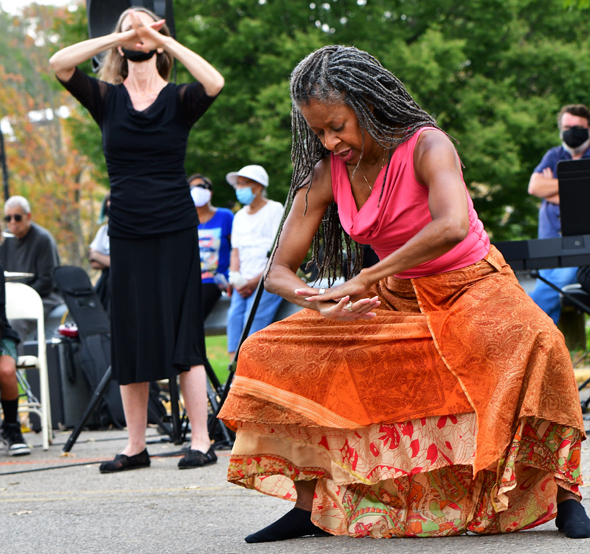
Valerie Blackwell-Truitt performed an interpretive dance as the Word House Choir sang a spiritual hymn. (Photo by Kathleen Galarza)
Making a sculpture
Borchers told the News that the four-year-long process of bringing the statue to life was a long road — and not without its setbacks.
He said he was approached in 2017 by local historian Steven Deal and artist Nancy Mellon — the current occupants of Wheeling Gaunt’s former home on Walnut Street — with the idea of the Arts Council leading the charge to create a statue of Wheeling Gaunt. According to Borchers, Mellon, then gallery director for the Arts Council. was already roping in local sculptor Brian Maughan to help with the project.
Maughan, a nationally recognized artist who moved to Yellow Springs from New York in 2006, had created sculpture installations of radio announcer Bob Uecker and baseball commissioner Bud Selig. He also created a bust of Gaunt, which was unveiled in January 2017 and is now part of the Arts Council’s permanent collection on view at Antioch University Midwest.
“In my gut, I knew we could do this,” Borchers said. “But [the Arts Council] first had to see what resources we had.”
Upon unanimous enthusiasm from Arts Council members, the Wheeling Gaunt Sculpture Project was underway.
“We administered the project, did all the fundraising, advertising, grant writing and provided leadership,” Borchers said.
“We took care of all that, but really we wanted as many voices involved in this project as possible.”
Local groups such as The 365 Project, the Yellow Springs Historical Society, Yellow Springs Heritage, the Yellow Springs Arts & Culture Commission, the Yellow Springs Chamber of Commerce and even Yellow Springs Schools were brought into the mix. Development, sculpture and site committees were formed.
According to past News reporting, the estimated fundraising goal in 2017 for the project was set at $114,870, which was the estimate given to organizers by Maughan. Now, Borchers said that the current budget is at $210,000 — the difference, he said, accounts for additional landscaping costs, an artist stipend and adding future educational materials and signage around the plaza.
“So we are still accepting donations for those future additions,” Borchers added.
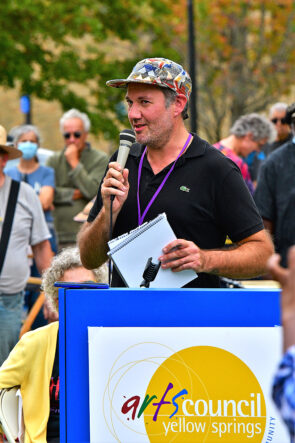
Anthony Maughan, sculptor and son of Gaunt sculpture designer Brian Maughan, had prepared a brief speech for the unveiling, but was unable to deliver it because of a sudden downpour. (Photo by Kathleen Galarza)
While the committees and groups involved in the Gaunt Sculpture Project made steady headway in generating local interest and garnering contributions for the project over the first three years, 2020 was rife with setbacks.
Not only did the COVID-19 pandemic upend all scheduling and disrupt communication, but Maughan died in August 2020 at the age of 78 — with the Wheeling Gaunt statue still in progress.
But not long after his father’s death, Anthony Maughan stepped in and picked up where his father left off.
In a follow-up interview with the younger Maughan, he said about three months after his father’s death, he felt called to finish his father’s sculpture.
“After he passed away, I realized fairly quickly that I’d be the best fit to take up the project,” Maughan told the News.
Originally from Virginia, but currently based and working out of Detroit, Mich., Maughan said that he has worked on sculptures on his own for the past few years — drawing from the preliminary training his father gave him over his life. But according to Maughan, he tends to prefer oil painting as his medium of choice.
“It was such a deep honor for me and my father to work on this project — together, in a way,” he said.
Maughan explained that working on the Wheeling Gaunt sculpture was a way for him to process the grief of his father’s loss, while still serving a community that he knew his father loved. Despite his overwhelming emotions, Maughan knew he had a job to do, and he wanted to enact the professionalism he saw in his father’s work habits.
“I tried to disentangle my grief from the project,” he explained. “With a sculpture like this, my dad’s approach to sculpture making was not to put too much of himself into it. It wasn’t about him, and this sculpture wasn’t about me.”
“Like my dad, I wanted to take it seriously.”
A lasting legacy
“[Wheeling Gaunt] was one of the best citizens of our village and will leave a record and example of his fair dealing and benevolence which would be well to imitate by those who are left behind.”
These words appear in Gaunt’s obituary in the Xenia Gazette, on May 15, 1894. According to the sculpture project organizers, this call to action — to “imitate” the man’s “fair dealing and benevolence” — underpinned the ethos of creating the Gaunt statue.
“We wanted Wheeling Gaunt to be more recognized and appreciated,” Borchers said. “Simply put, that was our objective: to create a lifesize sculpture of the guy so people could get to know him better.”
As Borchers said, most people tend to associate Wheeling Gaunt with the Village-owned Gaunt Park on West South College Street, or with the 126-year-old tradition of the delivery of flour to local widows and widowers at the holidays.
“But not many people really know more than that,” Borchers said.
While the details from much of Gaunt’s life are shrouded in uncertainty and speculation, local historians do know some facts.
“A brief biographical sketch of Wheeling Gaunt is both straightforward and remarkable,” explained Kevin McGruder in his keynote presentation at the unveiling event.
Gaunt was born into slavery on a plantation just south of the Ohio River in Carrollton, Ky., in 1812. Gaunt was fathered by his enslaver, John Gaunt. And according to Brenda Hubbard, author of “Legacy of Grace: Musings on the Life and Times of Wheeling Gaunt,” it’s likely that John sold Gaunt’s mother, Nancy, to another enslaver when Gaunt was only 4 years old.
Around 1845, Gaunt had saved enough money to purchase his freedom for $900, the freedom of his first wife, Amanda, for $500, as well as the freedom of a boy named Nicholas — “possibly Gaunt’s son,” McGruder said. Then, as a free man, Gaunt remained in Carrollton with his family and began purchasing real estate: several buildings throughout the region.
“In all likelihood, [Gaunt] observed the security and status of power that land ownership gave his father,” McGruder explained. “He invested his savings as a free laborer to root himself in the community.”
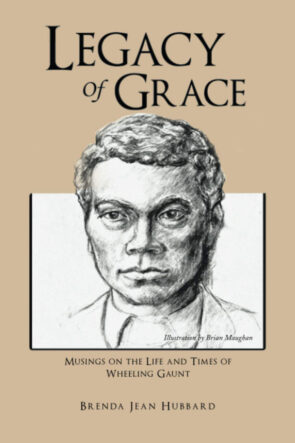
The cover of Legacy of Grace: Musings on the Life and Times of Wheeling Gaunt, by Brenda Jean Hubbard (Submitted photo)
Gaunt would carry this enterprising spirit to Yellow Springs in the early 1860s — right as the Civil War was beginning. Gaunt and his family moved into a house at 131 N. Walnut St. in the northern section of the village. According to Hubbard and McGruder’s research, Gaunt would continue working as a laborer and began investing his savings in property around Yellow Springs.
During his remaining years in Yellow Springs, Gaunt intricately wove himself into the social fabric of the community. McGruder said Gaunt was affiliated with Wilberforce University, Antioch College, Central Chapel AME Church and other community organizations and groups. In 1887, the year the Ohio Legislature mandated desegregation in public schools, Gaunt ran for Yellow Springs school board. Although he didn’t win, Gaunt’s campaign suggests to McGruder that he must have had an impressive network of social connections in and around Yellow Springs.
“He was a generous man,” McGruder said. “At one point, he sold at least two homes to people for just $1, and he donated $5,000 to Wilberforce University.”
By the year of Gaunt’s death in 1894, at the age of 82, he owned the entire northeast side of Walnut Street between Dayton and Cliff streets, and several other properties throughout the village, including the nine acres of land on West South College Street. At his death, his will provided for his second wife, Elizabeth; his sister, Louise; and stipulated that the Village annually donate a bag of flour to every widow in the community. His will also bequeathed the nine-acre parcel of land on West South College Street to the Village. The rest of his Yellow Springs real estate was left to Wilberforce University, McGruder said.
“So, we can see his motto [‘Not what we have, but what we share.’] as a good description of how Wheeling Gaunt lived his life, through the way in which he shared his substantial wealth with Yellow Springs and with Wilberforce,” McGruder said.
“By welcoming Gaunt, Yellow Springs benefited from his resourcefulness and his generosity.”
The Wheeling Gaunt Sculpture Project sculpture committee includes Karen McKee, John Fleming, Chris Zurbuchen, Kevin McGruder, Paul Graham, Richard Lapedes, Cheryl Durgans, Tara Anderson, Jerome Borchers, Anthony Maughan and the late Brian Maughan.
The site committee includes Neenah Ellis, Johnnie Burns, Lisa Kreeger, John Hudson, Nadia Malarkey, Dawn Knickerbocker, Steven Deal, Valerie Blackwell-Truitt and Anthony Maughan, Kevin McGruder and Brenda Hubbard.
3 Responses to “Wheeling Gaunt sculpture unveiled in downtown Yellow Springs”
The Yellow Springs News encourages respectful discussion of this article.
You must login to post a comment.
Don't have a login? Register for a free YSNews.com account.















Just for the record, Mr. Wheeling Gaunt was a supportive contributor to the local AME Church.
According to Wikipedia the AME mission creed includes:
preaching the gospel,
feeding the hungry,
clothing the naked,
housing the homeless,
cheering the fallen,
providing jobs for the jobless,
administering to the needs of those in prisons, hospitals, nursing homes, asylums and mental institutions, senior citizens’ homes; caring for the sick, the shut-in, the mentally and socially disturbed,
encouraging thrift and economic advancement.,[32] and
bringing people back into church
Pouring libations when out of doors is always to be done straight onto the earth, without exception.
It is a very pleasant looking sculpture indeed! I have to admit that I’m not one who favors erecting monuments but I do know how forgetful we humans are and by committing someone to bronze we are saying “we will never forget your kindness.” Ironically, those like Mr. Gaunt who are most worthy to be remembered would probably be the first to humbly ask not to erect such a thing! It is for the living, mind you, moving forward and for that “Thank You.”